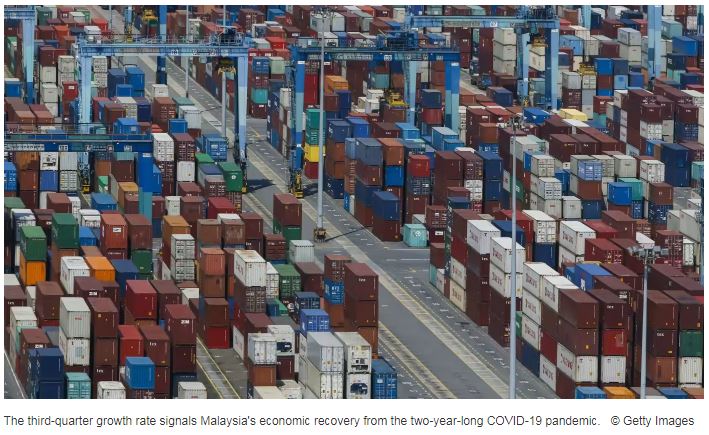Malaysia’s Q3 GDP grew 14.2%, highest in over a year
Growth beat forecasts with strong exports, accelerated from previous quarters
KUALA LUMPUR — Malaysia’s gross domestic product grew 14.2% in the third quarter compared to the same period last year, its central bank announced on Friday, signaling economic recovery from the two-year-long COVID-19 pandemic, although fear of a global slowdown remains.
After Malaysia’s economy expanded 5% and 8.9% in the first and second quarters, positioning it as one of the fastest-growing Southeast Asian economies post-pandemic, growth in the July-September period further accelerated, hitting the highest rate of growth since the second quarter of 2021, when the economy expanded 15.9%, according to the central bank’s statistics.
According to the central bank, the economy expanded as much as 15.8% in July.
The result beat the 11.7% median estimate of 22 economists polled by Reuters. The economists expected high growth due to a lower statistical base in the third quarter of 2021 and bullish exports. A similar poll by Bloomberg arrived at a median growth target of 12.1%.
Continued expansion in domestic demand, firm recovery in the labor market and robust exports are among the primary factors that supported the third quarter’s economic growth, central bank Gov. Nor Shamsiah Yunus told a news conference on Friday.
“We have witnessed expansion in activities across all economic sectors in the third quarter,” she said, similar to the preceding quarter, “which includes services, manufacturing, agriculture, mining and construction.”
The central bank estimates growth of between 6.5% and 7% this year, backed by continued expansion in global demand and higher expenditures in the private sector. It expects growth to slow down next year to between 4% and 5%.
The economy widened by 3.1% in 2021, bouncing back from a contraction of 5.6% in 2020.
“The Malaysian economy will continue to be supported by firm domestic demand amid continued improvements in the labor market, and growth would also benefit from the realization of large infrastructure projects as well as higher tourist arrivals,” said Nor Shamsiah.
“However, Malaysia’s growth remains susceptible to a weaker-than-expected global growth, higher risk aversion in global financial markets, further escalation of geopolitical conflicts and re-emergence of supply chain disruptions,” she stressed.
The International Monetary Fund in August slashed its year-on-year economic growth forecast for Malaysia to 5.1% in 2022, from 5.6% previously, citing a gloomy global economic outlook and rising geopolitical tensions.
The central bank made four consecutive hikes in its benchmark rate between May and November to 2.75% after lowering it to a historic low of 1.75% in July 2020.
The bank also projected headline inflation to average 3.3% in 2022 and between 2.8% and 3.3% next year, given the improvement in economic activity amid lingering cost pressures.
“Core inflation is expected to average closer to the upper end of the 2%-3% forecast range in 2022, given some demand-driven price pressures amid the high-cost environment,” she said.
“Moving into 2023, inflation is expected to remain elevated, with the outlook subject to domestic policy measures on subsidies, global commodity developments and prolonged supply-related disruptions,” the governor added.
Source: https://asia.nikkei.com/Economy/Malaysia-s-Q3-GDP-grew-14.2-highest-in-over-a-year


 Thailand
Thailand






